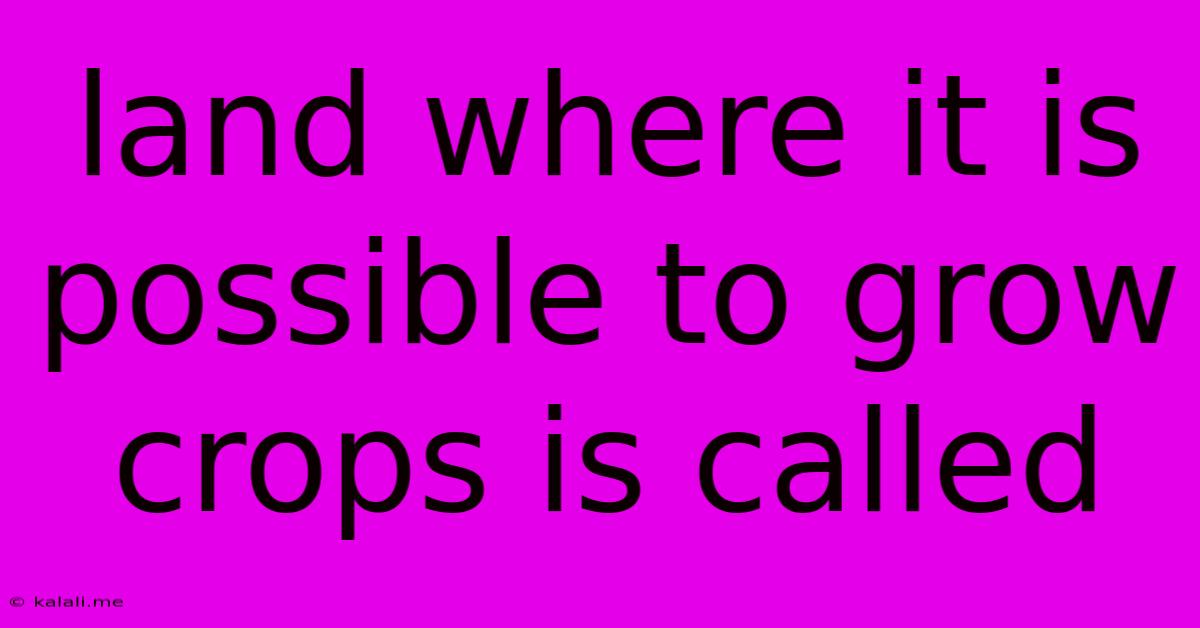Land Where It Is Possible To Grow Crops Is Called
Kalali
Jun 15, 2025 · 3 min read

Table of Contents
Land Where It Is Possible to Grow Crops Is Called: A Deep Dive into Arable Land and its Importance
This article explores the term for land suitable for cultivating crops, examining its characteristics, global distribution, and significance in food security and sustainable agriculture. Understanding arable land is crucial for addressing issues of food production, land management, and environmental sustainability.
What is Arable Land?
Arable land refers to land that is suitable for growing crops. This means the land possesses the necessary characteristics to support plant life, including fertile soil, sufficient water access, and a suitable climate. It's the foundation of agriculture and a vital resource for feeding the global population. Other terms sometimes used interchangeably, although with slightly different connotations, include cultivable land, farmland, and agricultural land. However, arable land specifically denotes land currently used or readily usable for crop production.
Key Characteristics of Arable Land:
Several factors contribute to the suitability of land for cultivation:
- Soil Quality: Fertile soil rich in organic matter, nutrients (like nitrogen, phosphorus, and potassium), and with good drainage is essential for healthy crop growth. Soil texture and structure also play a significant role.
- Climate: Appropriate temperature and rainfall are crucial. The growing season needs to be long enough for crops to mature, and rainfall must be sufficient to avoid drought, although irrigation can mitigate this.
- Topography: Flat or gently sloping land is easier to cultivate and irrigate than steep terrain. Slope and drainage influence soil erosion and water management.
- Water Availability: Access to sufficient water for irrigation is crucial in many regions, especially during dry seasons. The proximity to water sources, whether rivers, lakes, or groundwater, significantly impacts arable land productivity.
Global Distribution and Challenges:
Arable land is not evenly distributed across the globe. Many factors, including climate, geography, and human activities, influence its availability. Some regions have abundant arable land, while others face significant limitations. Challenges include:
- Land Degradation: Unsustainable agricultural practices, like deforestation, overgrazing, and intensive monoculture farming, lead to soil erosion, nutrient depletion, and desertification, reducing arable land's productivity.
- Climate Change: Changes in temperature and rainfall patterns, increased frequency of extreme weather events (droughts, floods), and rising sea levels threaten arable land and crop yields.
- Urbanization and Infrastructure Development: The expansion of cities and the construction of infrastructure often lead to the conversion of arable land for non-agricultural purposes.
- Population Growth: The increasing global population puts immense pressure on arable land to produce enough food to feed everyone.
The Importance of Protecting Arable Land:
Arable land is a finite resource. Protecting and sustainably managing this resource is crucial for global food security. Strategies for improving and preserving arable land include:
- Sustainable Agriculture Practices: Implementing techniques such as crop rotation, cover cropping, no-till farming, and integrated pest management minimizes soil degradation and enhances soil fertility.
- Efficient Irrigation Systems: Adopting water-efficient irrigation techniques minimizes water waste and reduces the environmental impact of agriculture.
- Precision Agriculture: Using technology to monitor and manage crop growth precisely optimizes resource use and improves yields.
- Land Use Planning: Careful planning and zoning regulations can prevent the conversion of valuable arable land to other uses.
In conclusion, arable land is the land suitable for cultivating crops, a crucial resource for food production and global sustainability. Understanding its characteristics, distribution, and the challenges it faces is essential for developing effective strategies to ensure food security for present and future generations. Protecting and sustainably managing this precious resource is a global priority.
Latest Posts
Latest Posts
-
The Concept Of Emotional Intelligence Was First Introduced By
Jun 15, 2025
-
How To Find Derivative Of An Integral
Jun 15, 2025
-
Alternate Forms Of A Gene Are Produced By
Jun 15, 2025
-
Which Of The Following Is A Probability Sampling Technique
Jun 15, 2025
-
Efflorescence In Bricks Is Caused By
Jun 15, 2025
Related Post
Thank you for visiting our website which covers about Land Where It Is Possible To Grow Crops Is Called . We hope the information provided has been useful to you. Feel free to contact us if you have any questions or need further assistance. See you next time and don't miss to bookmark.